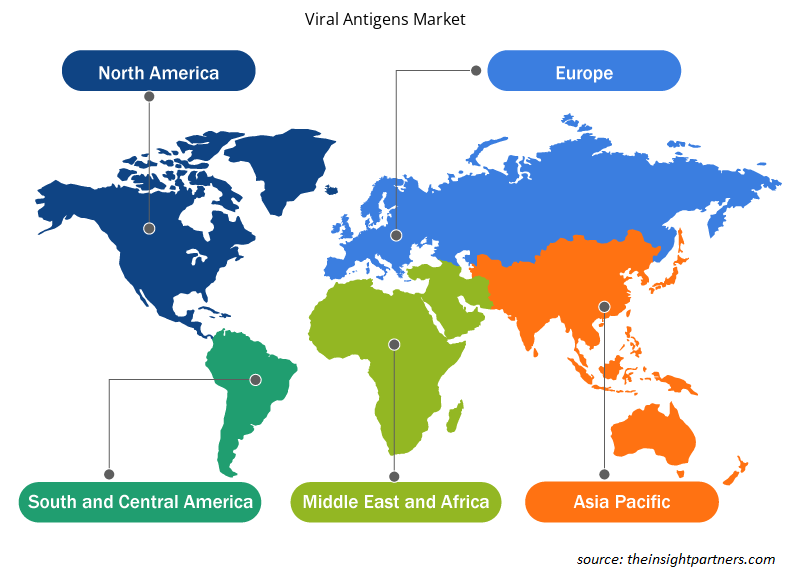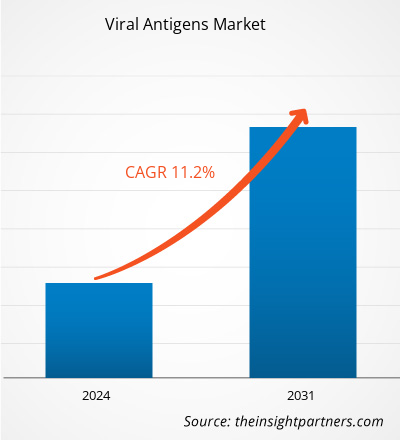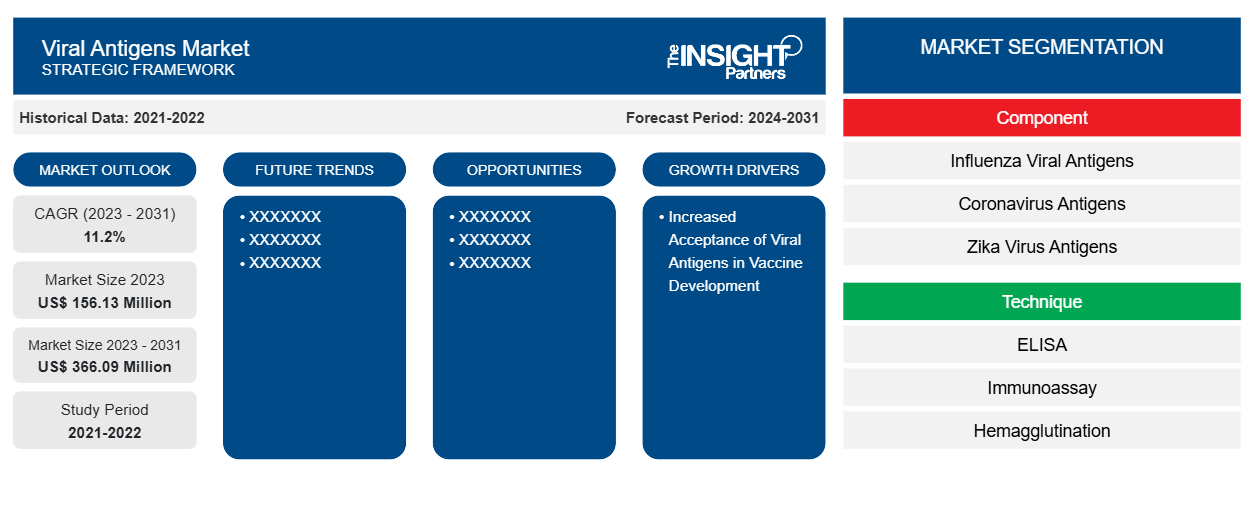Si stima che la dimensione del mercato degli antigeni virali sia stata di 156,13 milioni di dollari USA nel 2023 e si prevede che raggiungerà i 366,09 milioni di dollari USA entro il 2031; si stima che registrerà un CAGR dell'11,2% fino al 2031. È probabile che lo sviluppo di antigeni vaccinali di origine vegetale e di prodotti biofarmaceutici rimangano tendenze chiave del mercato degli antigeni virali.
Analisi di mercato degli antigeni virali
La crescente prevalenza di infezioni virali in tutto il mondo, tra cui HIV, influenza, epatite e virus respiratori come COVID-19, spinge la domanda di antigeni virali che vengono utilizzati negli studi diagnostici. I progressi nella biologia molecolare, le iniziative governative per lo sviluppo di vaccini contro i virus emergenti, le crescenti attività di R&S per lo sviluppo di tecniche diagnostiche e vaccini e i crescenti investimenti nella ricerca sugli antigeni virali stanno alimentando la crescita del mercato degli antigeni virali.
Panoramica del mercato degli antigeni virali
Un virus può infettare tutti i tipi di forme di vita, dalle piante e dagli animali agli archaea e ai batteri. Un antigene virale è un veleno o una sostanza tossica somministrata da un virus che induce una reazione immunitaria nel suo ospite. Una proteina virale è un antigene identificato dal genoma virale che può essere riconosciuto attraverso una particolare risposta immunologica. Un antigene virale è determinato dall'IFA nei neutrofili e nelle piastrine del midollo osseo o del sangue o nel siero, nella saliva, nelle lacrime o nel plasma tramite ELISA. I test di amplificazione nucleica possono anche essere utilizzati per determinare lo stadio dell'infezione. I risultati migliori si ottengono quando gli antigeni vengono misurati tramite esami del sangue o del siero.
Personalizza questo report in base alle tue esigenze
Riceverai la personalizzazione gratuita di qualsiasi report, comprese parti di questo report, o analisi a livello nazionale, pacchetto dati Excel, oltre a usufruire di grandi offerte e sconti per start-up e università
-
Scopri le principali tendenze di mercato in questo rapporto.Questo campione GRATUITO includerà analisi di dati che spaziano dalle tendenze di mercato alle stime e alle previsioni.
Driver e opportunità del mercato degli antigeni virali
Maggiore consapevolezza degli antigeni virali nello sviluppo dei vaccini
Gli antigeni virali svolgono un ruolo importante nello sviluppo dei vaccini, in quanto sono la componente rilevata dal sistema immunitario per la protezione. Ad esempio, quando una persona è infetta da un virus, il suo sistema immunitario riconosce specifici antigeni virali come estranei e organizza una risposta per eliminare il virus. Gli antigeni virali nei vaccini espongono il sistema immunitario a questi antigeni specifici in modo controllato e quindi aiutano la persona a sviluppare una risposta immunitaria contro il virus. Lo sviluppo e l'uso di vaccini hanno notevolmente ridotto il numero di malattie e patologie nel corso degli anni. L'introduzione di una varietà di nuovi tipi di vaccini è stata resa possibile attraverso la manipolazione di DNA , RNA, proteine e zuccheri, una maggiore conoscenza della risposta immunitaria e un importante balzo in avanti nell'ingegneria genetica. Lo sviluppo di mutanti attenuati, l'espressione di possibili antigeni in vettori vivi e la purificazione e la sintesi diretta di antigeni in nuovi sistemi hanno notevolmente migliorato la tecnologia dei vaccini. Pertanto, si prevede che una maggiore accettazione degli antigeni virali nello sviluppo dei vaccini guiderà il mercato durante il periodo di previsione.recognises specific viral antigens as foreign and mounts a response to eliminate the virus. Viral antigens in vaccines exposes the immune system to these specific anitgens in a controlled manner and thus helping the person to develop immune response against the virus. The development and use of vaccines has greatly reduced the number of illnesses and diseases over the years. The introduction of a variety of new types of vaccines has been made possible through the manipulation of
Crescente consapevolezza sulla sanità preventiva: un’opportunità per il mercato degli antigeni virali
L'assistenza sanitaria preventiva si concentra sulla prevenzione dei problemi di salute e sulla diagnosi dei problemi prima che si sviluppino sintomi o complicazioni. La vaccinazione svolge un ruolo cruciale nell'assistenza sanitaria preventiva in quanto può rafforzare l'immunità di una persona alle infezioni virali prima che la persona sia esposta al virus. Nel caso dell'assistenza sanitaria preventiva, i vaccini sviluppati sono generalmente costituiti da antigeni virali in modo che il sistema immunitario li rilevi. Pertanto, una maggiore consapevolezza dell'assistenza sanitaria preventiva attraverso la vaccinazione sta alimentando la crescita del mercato degli antigeni virali.
Analisi della segmentazione del rapporto di mercato degli antigeni virali
I segmenti chiave che hanno contribuito alla derivazione dell'analisi di mercato degli antigeni virali sono componente, tecnica e utente finale.
- In base al componente, il mercato degli antigeni virali è segmentato in antigeni virali dell'influenza, antigeni del coronavirus, antigeni del virus Zika, antigeni del virus Ebola, antigeni del virus Dengue, antigeni virali del virus Herpes Simplex (HSV), antigeni virali del rotavirus, antigeni del virus dell'epatite AE, antigeni del virus del morbillo, antigeni del virus della parotite/parotite e altri. Il segmento degli antigeni virali dell'influenza ha detenuto la quota di mercato più grande nel 2023. Ogni anno il CDC caratterizza antigenicamente circa 2.000 virus influenzali per confrontare quanto siano simili i virus influenzali attualmente in circolazione a quelli utilizzati nel vaccino antinfluenzale e per rilevare cambiamenti nei virus influenzali circolanti. La caratterizzazione antigenica può implicare la capacità del vaccino antinfluenzale di indurre una risposta immunitaria contro i virus influenzali che circolano negli esseri umani.HSV) Viral Antigens, Rotavirus Viral Antigens, Hepatitis A-E Virus Antigens, Measles Virus Antigens, Mumps/Parotitis Virus Antigens, and others. The influenza viral antigens segment held the largest market share in 2023. Around 2,000 influenza viruses are antigenically characterized by the CDC each year to compare how similar currently circulating influenza viruses are to those used in the influenza vaccine and to detect changes in circulating influenza viruses. Antigenic characterization may imply the capacity of the flu vaccine to induce an immune response against influenza viruses that circulate in humans.
- Per tecnica, il mercato è segmentato in ELISA, Immunoassay, Hemagglutination, Radioimmunoassay (RIA), Immunoperoxidase Staining, Immunofluorescence e altri. Il segmento ELISA ha detenuto la quota maggiore del mercato nel 2023.
- In termini di utente finale, il mercato è segmentato in Ospedali, Cliniche, Laboratori, Centri diagnostici, Banche del sangue e Istituti di ricerca. Il segmento diagnostico ha dominato il mercato nel 2023.
Analisi della quota di mercato degli antigeni virali per area geografica
L'ambito geografico del rapporto sul mercato degli antigeni virali è suddiviso principalmente in cinque regioni: Nord America, Asia Pacifico, Europa, Medio Oriente e Africa e Sud America/Sud e Centro America.
Il Nord America ha dominato il mercato degli antigeni virali. In Nord America, gli Stati Uniti detengono una quota significativa del mercato delle terapie per la sclerosi multipla. La crescita del mercato nel paese è principalmente guidata da un vasto numero di attività di R&S per lo sviluppo di vaccini, aiuti finanziari da parte di governi, altre organizzazioni private e non private per i farmaci vaccinali e una crescente prevalenza di infezioni virali nel paese. Inoltre, si prevede che una maggiore consapevolezza riguardo all'assistenza sanitaria preventiva stimolerà l'adozione e l'accettazione dei prodotti durante il periodo di previsione.
Approfondimenti regionali sul mercato degli antigeni virali
Le tendenze regionali e i fattori che influenzano il mercato degli antigeni virali durante il periodo di previsione sono stati ampiamente spiegati dagli analisti di Insight Partners. Questa sezione discute anche i segmenti e la geografia del mercato degli antigeni virali in Nord America, Europa, Asia Pacifico, Medio Oriente e Africa e America meridionale e centrale.

- Ottieni i dati specifici regionali per il mercato degli antigeni virali
Ambito del rapporto di mercato sugli antigeni virali
| Attributo del report | Dettagli |
|---|---|
| Dimensioni del mercato nel 2023 | 156,13 milioni di dollari USA |
| Dimensioni del mercato entro il 2031 | 366,09 milioni di dollari USA |
| CAGR globale (2023-2031) | 11,2% |
| Dati storici | 2021-2022 |
| Periodo di previsione | 2024-2031 |
| Segmenti coperti |
Per componente
|
| Regioni e Paesi coperti |
America del Nord
|
| Leader di mercato e profili aziendali chiave |
|
Densità degli attori del mercato degli antigeni virali: comprendere il suo impatto sulle dinamiche aziendali
Il mercato degli antigeni virali sta crescendo rapidamente, spinto dalla crescente domanda degli utenti finali dovuta a fattori quali l'evoluzione delle preferenze dei consumatori, i progressi tecnologici e una maggiore consapevolezza dei benefici del prodotto. Con l'aumento della domanda, le aziende stanno ampliando le loro offerte, innovando per soddisfare le esigenze dei consumatori e capitalizzando sulle tendenze emergenti, il che alimenta ulteriormente la crescita del mercato.
La densità degli operatori di mercato si riferisce alla distribuzione di aziende o società che operano in un particolare mercato o settore. Indica quanti concorrenti (operatori di mercato) sono presenti in un dato spazio di mercato in relazione alle sue dimensioni o al valore di mercato totale.
Le principali aziende che operano nel mercato degli antigeni virali sono:
- Microbix Biosistemi
- LABORATORI BIO-RAD INC.
- Diagnostica creativa
- Aalto Bio Reagents Ltd.
- Tecnologie avanzate per la biotecnologia Inc.
- Prospec-Tany Technogene Ltd.
Disclaimer : le aziende elencate sopra non sono classificate secondo un ordine particolare.

- Ottieni una panoramica dei principali attori del mercato degli antigeni virali
Notizie e sviluppi recenti sul mercato degli antigeni virali
Il mercato degli antigeni virali viene valutato raccogliendo dati qualitativi e quantitativi dopo la ricerca primaria e secondaria, che include importanti pubblicazioni aziendali, dati di associazioni e database. Di seguito è riportato un elenco degli sviluppi nel mercato degli antigeni virali e delle strategie:
- Sino Biological Inc ha lanciato la più grande collezione di antigeni virali ricombinanti al mondo, ProVir. La linea di prodotti presenta un'ampia gamma di proteine ricombinanti di alta qualità espresse in cellule di insetti e mammiferi. Questi prodotti sono rigorosamente testati per la loro purezza e bioattività. Questo portafoglio include oltre 800 prodotti di 45 tipi diversi, 350 ceppi di virus. (Fonte: Sino Biological Inc, sito Web aziendale, 2020)
Copertura e risultati del rapporto sul mercato degli antigeni virali
Il rapporto "Dimensioni e previsioni del mercato degli antigeni virali (2021-2031)" fornisce un'analisi dettagliata del mercato che copre le seguenti aree:
- Dimensioni e previsioni del mercato a livello globale, regionale e nazionale per tutti i segmenti di mercato chiave coperti dall'ambito
- Dinamiche di mercato come fattori trainanti, vincoli e opportunità chiave
- Principali tendenze future
- Analisi dettagliata delle cinque forze PEST/Porter e SWOT
- Analisi di mercato globale e regionale che copre le principali tendenze di mercato, i principali attori, le normative e gli sviluppi recenti del mercato
- Analisi del panorama industriale e della concorrenza che copre la concentrazione del mercato, l'analisi della mappa di calore, i principali attori e gli sviluppi recenti
- Profili aziendali dettagliati
- Analisi storica (2 anni), anno base, previsione (7 anni) con CAGR
- Analisi PEST e SWOT
- Valore/volume delle dimensioni del mercato - Globale, Regionale, Nazionale
- Industria e panorama competitivo
- Set di dati Excel
Report recenti
Testimonianze
Motivo dell'acquisto
- Processo decisionale informato
- Comprensione delle dinamiche di mercato
- Analisi competitiva
- Analisi dei clienti
- Previsioni di mercato
- Mitigazione del rischio
- Pianificazione strategica
- Giustificazione degli investimenti
- Identificazione dei mercati emergenti
- Miglioramento delle strategie di marketing
- Aumento dell'efficienza operativa
- Allineamento alle tendenze normative























 Ottieni un campione gratuito per - Mercato degli antigeni virali
Ottieni un campione gratuito per - Mercato degli antigeni virali